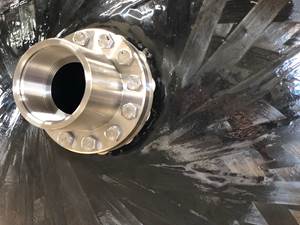21st century concrete: composite metamaterial with super compressability, energy harvesting
Material comprising 3D-printed, auxetic, reinforced polymer lattices in conductive cement matrix can compress up to 15% and generate electricity for lightweight, mechanically tunable structures with energy harvesting and sensing.
Photo Credit: University of Pittsburgh Swanson School of Engineering
Concrete is the most used material in the construction industry and dates to the Roman Empire. Engineers at the University of Pittsburgh (Pitt, Pittsburgh, Pa., U.S.) are now re-imagining its design for the 21st century.
New research introduces metamaterial concrete for the development of smart civil infrastructure systems. The paper, "," presents a new concept for lightweight and mechanically tunable concrete systems that have integrated energy harvesting and sensing functionality.
Future relevance of the proposed nanogenerator-integrated metamaterial concrete in smart infrastructure systems: a) A high energy absorbing engineered materials arresting system; b) A shock absorbent bike lane pavement; c) Metamaterial concrete base isolation system. Photo Credit: Fig. 5, “” by Kaveh Barri, Amir Alavi, et al., Adv. Mater. 2023, 2211027.
“Modern society has been using concrete in construction for hundreds of years,” says Amir Alavi, assistant professor of civil and environmental engineering at Pitt, who is the corresponding author on the study. “Our massive use of concrete in infrastructure highlights the need for developing a new generation of concrete materials that are more economical and environmentally sustainable yet offer advanced functionalities. We believe that we can achieve all of these goals by introducing a metamaterial paradigm into the development of construction materials.”
Alavi and his team have previously developed and explored their use in applications like . This new study introduces the use of metamaterials in the creation of concrete, making it possible for the material to be specifically designed and tailored in its attributes such as load-bearing capability, flexibility and shapeability. These can be fine-tuned in the creation of the material, enabling builders to use less material without sacrificing strength or durability.
Multifunctional metamaterial concrete. a) Schematic of metamaterial concrete with 3 × 3 unit cells. b) Composition of nanogenerator-integrated metamaterial concrete matrix with embedded conductive and non-conductive layers. c) Working mechanism of the unit cells of a nanogenerator-integrated metamaterial concrete. Photo Credit: Fig. 1, “”.
“This project presents the first composite metamaterial concrete with super compressibility and energy harvesting capability,” said Alavi. “Such lightweight and mechanically tunable concrete systems can open a door to the use of concrete in various applications such as shock absorbing engineered materials at airports to help slow runaway planes or seismic isolation systems.”
The material is also capable of generating electricity — not enough to send power to the electrical grid, but more than enough to power roadside sensors. The electrical signals self-generated by the metamaterial concrete under mechanical excitations can also be used to perform structural health monitoring (SHM), measuring damage inside the concrete structure or to monitor loads and stresses during earthquakes.
Eventually, these smart structures may even power chips embedded inside roads to help self-driving cars navigate on highways when GPS signals are too weak, or when LIDAR is not working.
Super-compressible metamaterial concrete systems fabricated at the University of Pittsburgh with 3×3 unit cells (left) and 5×5 unit cells (right). The proposed concrete systems are tuned to achieve up to 15% compressibility under cycling loading. Photo Credit: Fig.2, “”.
The material developed at Pitt comprises reinforced auxetic polymer lattices embedded in a conductive cement matrix. The composite structure induces contact-electrification between the layers when triggered mechanically. The conductive cement, which is enhanced with graphite powder, serves as the electrode in the system. Experimental studies show that the material can compress up to 15% under cyclic loading and produce 330 microwatts of power.
Alavi and his research team are partnering with the Pennsylvania Department of Transportation (PennDOT) through the at Pitt to develop this metamaterial concrete for use on Pennsylvania roads. The project also included researchers from Johns Hopkins University, New Mexico State University, the Georgia Institute of Technology and the Beijing Institute of Nanoenergy and Nanosystems.
Related Content
Carbon fiber, bionic design achieve peak performance in race-ready production vehicle
Porsche worked with Action Composites to design and manufacture an innovative carbon fiber safety cage option to lightweight one of its series race vehicles, built in a one-shot compression molding process.
Read MorePlant tour: Teijin Carbon America Inc., Greenwood, S.C., U.S.
In 2018, Teijin broke ground on a facility that is reportedly the largest capacity carbon fiber line currently in existence. The line has been fully functional for nearly two years and has plenty of room for expansion.
Read MorePrepreg compression molding supports higher-rate propeller manufacturing
To meet increasing UAV market demands, Mejzlik Propellers has added a higher-rate compression molding line to its custom CFRP propeller capabilities.
Read MoreInfinite Composites: Type V tanks for space, hydrogen, automotive and more
After a decade of proving its linerless, weight-saving composite tanks with NASA and more than 30 aerospace companies, this CryoSphere pioneer is scaling for growth in commercial space and sustainable transportation on Earth.
Read MoreRead Next
Cutting 100 pounds, certification time for the X-59 nose cone
Swift Engineering used HyperX software to remove 100 pounds from 38-foot graphite/epoxy cored nose cone for X-59 supersonic aircraft.
Read MoreCeramic matrix composites: Faster, cheaper, higher temperature
New players proliferate, increasing CMC materials and manufacturing capacity, novel processes and automation to meet demand for higher part volumes and performance.
Read MoreNext-gen fan blades: Hybrid twin RTM, printed sensors, laser shock disassembly
MORPHO project demonstrates blade with 20% faster RTM cure cycle, uses AI-based monitoring for improved maintenance/life cycle management and proves laser shock disassembly for recycling.
Read More












